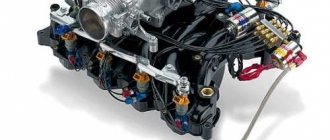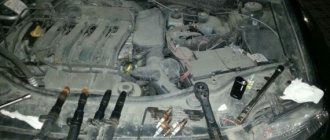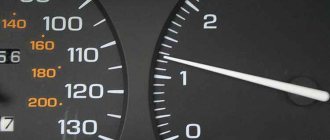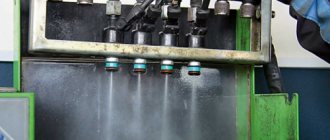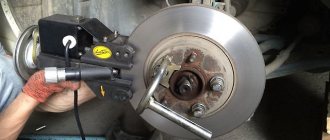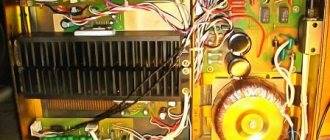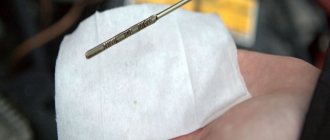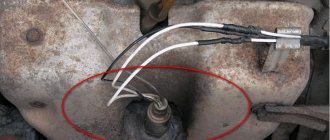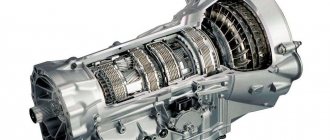Mechanical problems
First, you should check the throttle cable. Quite often it jams, and the pedal “sticks” when the driver has already removed his foot and the speed has not decreased. This may be due to the following problems:
- Corrosion of the cable. At the same time, it simply gets stuck in the shirt;
- Lubrication. Sometimes drivers, in an effort to improve the operation of the unit, lubricate the cable; in winter, the lubricant freezes, which causes jamming;
- Unsuccessful repair. In some cases, after repairs, car owners incorrectly position the cable, resulting in problems.
Therefore, be sure to check the condition of the cable. See how it moves and replace it if necessary.
Preparing to adjust the idle speed
If you do not plan to clean and disassemble the VAZ 2107 carburetor, then one of the tools you will need is a screwdriver. A device for measuring the speed (tachometer) is installed in the dashboard. But it’s worth getting a mixture quality indicator. With its help you can create an air-fuel mixture in ideal proportions. This article will talk about adjustment using this device.
Before starting work, you need to warm up the engine to operating temperature. Let us remember that this is a temperature of about 90 degrees. You also need to put the air purification filter in place to simulate normal engine operation. Make sure the float is adjusted correctly. The fuel level in the chamber must always be stable.
Electronics
The most common cause of unstable speed is a violation in the engine management system. Therefore, the first thing to do is to conduct computer diagnostics. In most cases, this can identify errors in specific sensors and check their operation. Below we look at the most common causes of the problem.
. Sometimes it may give incorrect signals, causing the RPM to increase. To check, you will have to remove the sensor from the car. It is also recommended to check the condition of the damper itself. Maybe
I don't close it completely. If a malfunction is detected, the sensor should be replaced. Just don't buy a cheap Chinese part; most likely, you'll need to buy it again soon. It's better to buy a normal sensor right away.
{banner_content}Damage to the engine control unit bus. Sometimes the wires that supply the signal to the on-board computer can become damaged. This happens when the repair is unsuccessful, when a car enthusiast accidentally breaks them. A breakdown can also occur due to a large amount of dirt accumulated on the tire.
The problem may also be caused by
. Diagnosis of this part is complicated by the lack of response to a malfunction of the engine control unit. Therefore, you will have to remove it in any case. It is essentially a small electric motor that drives a needle that regulates power to the motor. After removal, measure the resistance at the opposite terminals. The device should show
. When measuring resistance at adjacent terminals, the indicator should tend to infinity. If this is not the case, then the regulator is faulty and requires replacement. It must be said that an increase in speed when it fails is rarely observed; usually there are options with a missing idle speed.
If your car has a mass air flow sensor, then this is probably the cause. It rarely fails, but when it breaks down, in most cases it supplies the cylinders with a mixture that is too rich. An indirect sign is the presence of engine detonation. This sensor is quite expensive, and if the TPS can be bought and checked by simply replacing it, then it is better to carry out a thorough diagnosis.
The first thing to do is try to disconnect the sensor from power. In this case, the control unit begins to work, starting from the throttle position. If the sensor is faulty, then the motor operation returns to normal. Some sensor models can be checked using a multimeter. To do this, remove the mass air flow sensor, connect it to power, and measure the voltage at the terminals.
How to act in winter
There is a single algorithm with which you can start a VAZ-2107 without serious problems in the fuel supply, ignition or power supply systems. To successfully complete the procedure, you will need to have on hand dry, calcined spark plugs, a working and charged battery, and a special spray for the carburetor. Let's look at the launch procedure in more detail:
- Try to remove the battery at night to keep it warm. If you have not done this in the evening, then before you try to start your car, place the battery in a warm place for 20-30 minutes. Remember that when frost sets in, this battery loses its capacity by a quarter, so the inrush current also drops.
- If the temperature drop was not significant or heating the battery did not help, then turn on music in the car or flash the headlights a little in high beam mode. These simple steps will put a strain on the battery. If the quality of the battery is poor, you can charge it at low currents.
- Reinstall the prepared battery and try to start the engine. First, depress the clutch fully, and only then start cranking the starter.
- Warm up the power plant so that the oil becomes more liquid. Smoothly release the clutch to heat the lubricant in the gearbox.
- If the injector stalls during the gearbox warm-up stage, use cylinder blowing. This may not help, then remove the spark plugs and heat them. They may be flooded.
- For a cold start, a special spray is produced, which is injected into the carburetor behind the air vent. If you have an injector, then inject the spray into the corrugated hose, which is also located behind the air vent.
You should also know another popular starting method in winter - “lighting up”. It’s suitable if frost catches you on the road, and there is no way to bring the battery into a warm place. For this you will need a special starting battery or another car with a well-charged battery. Observe the following rules:
- park cars not close to each other;
- use only special cables with clamps;
- To avoid overloading the generator, do not give too much gas;
- connect the terminals observing polarity;
- the car must run for 3 minutes before you disconnect it from the “donor”.
Another common way to start an engine is by pushing. They rarely resort to it if nothing else has affected the car. In severe frost it may be ineffective, so initially all other methods are used.
Frost will not take you by surprise if you prepare your car for the cold in advance:
- change antifreeze;
- install a new set of spark plugs;
- pour anti-freeze liquid into the washer reservoir;
- install wheel arch liners;
- change the tires to studded ones;
- Spray WD-40 into the locks.
Such preparation will help maintain the car's driving performance even with a significant drop in temperature.
Other reasons
In practice, a problem can occur for many reasons, often even exotic ones that you might not immediately think of. For example, there are cases where such behavior of the motor occurred due to a generator malfunction. If it produces increased current, then the electronics begin to “go crazy”, which can be expressed, among other things, in sudden jumps in speed. If, after checking all the root causes, the source of the problem has not been identified, then check the performance of the generator.
The problem may also be in the engine ECU. If you have flashed the device, there is a possibility that it will not work correctly. Try updating the software, maybe the problem will go away.
https://www.youtube.com/watch?v=ytpressru
Conclusion. Modern cars have a large list of possible faults. Therefore, drivers may wonder why the car accelerates on its own at idle. This problem is quite common. There may be several reasons for this, both purely mechanical and related to the electronics controlling the motor.
VAZ 2107 revs fluctuate on a cold engine
Does your favorite car jerk at idle? At speed everything is fine and starts perfectly, but at idle it just dances? There are problems with the ignition or fuel system, for example, the check engine light comes on, or
halogen h3
which fogs are better for cue spectrum
Does your favorite car jerk at idle? At speed everything is fine and starts perfectly, but at idle it just dances? If there are malfunctions in the ignition or fuel system, for example, the check engine light comes on, or there are problems starting the engine, the car does not start well, the speed fluctuates? - this is a sure signal to pay attention to the health of your car and find the cause of the malfunction.
After several years of use. Normal startup, but instead of a smooth decrease in speed as it warms up, suddenly there is a “drop” in speed every few seconds
generator vaz 2114
The revolutions change abruptly in the range of 1300-500. With further warming up, the dips disappear, the engine speed stabilizes, and does not appear until the next “cold” start
yeah
But gradually this effect increases.
The cause turned out to be the engine temperature sensor. Of course, the best solution is to replace it.
Typically, the speed of engines with electronic fuel injection fluctuates and is associated with abnormal air leaks. The fact is that injection engines have a control unit, or as it is also called, a computer
xenon fog lights
This computer calculates the amount of air entering the cylinders and, taking into account the state of a number of sensors, opens the solenoid valves of the injectors (or one injector, if the system is Ci) at one time or another.
And so, when “extra” air comes in, and the throttle position sensor “says” that there shouldn’t be any, the temperature sensor says that the engine has already left the warm-up mode and less fuel needs to be poured, as a result, “that computer” has a “roof” is traveling,” he doesn’t know what to do with this “extra” air.
The reason for the floating speed, which occurs on engines with injection, is the crankcase ventilation valve sticking.
This whole situation leads to the fact that the engine speed periodically begins to change: then 800 rpm, then 1200 rpm, and so on with a period of about 3 seconds. We can also say that in this case the automatic regulation of the power system is disrupted and the speed begins to float.
In carburetor engines, the reason for the floating engine speed may be incorrect adjustment of some servomotor, which slightly opens the throttle valve in certain cases. Unscrew the adjusting screws of the servomotor, the drive of which jerks in time with the floating speed, and everything will immediately calm down
VAZ 2106 carburetor repair
This breakdown occurred only in those engines where they tried to regulate something, for example, many “craftsmen”, in order to find the idle speed adjustment screw on the carburetor (throttle valve thrust screw), turn all the screws little by little in a row. For God's sake.
But if the engine does not react to them in any way, they must be returned to their original state. And then it turns out that in some operating mode, gas gaps appear, the speed fluctuates, high fuel consumption, and so on.
In diesel engines, this defect (speeds float) can appear not only at idle, but also at 1000 rpm and at 1500 rpm. There has been only one reason for this so far - the moving blades in the feed pump are stuck. Seizing occurs only due to rust, and this is due to water in the fuel. This usually happens with cars that have been standing for a long time.
In fact, there are recommendations for the case when you are going to park your car with a diesel engine for a long time. Let's say you need to go on a business trip for a month.
car engine structure
On the eve of departure, fill the fuel tank with about a liter of motor oil and drive on this fuel for the last day.
The engine will smoke, but all the parts in the fuel injection pump will be covered with a thin oil film.
If your car “jerks” (speeds fluctuate), contact us. We will carry out a full or partial diagnosis of the car. Back to the list Ignition system malfunctions Diagnostics meeting Replacing spark plugs Auto repair service station (Kyiv) Car malfunctions Injection engine Check Engine Causes of car malfunctions Injector flushing
DIY high pressure washer
Cleaning the injector. Cleaning injectors.
Cleaning injectors VAZ spark plugs Diagnostic programs Lambda probe (lambda) Injector notes Idle speed, check and adjustment Idle air valve (IAC) Idle air control Idle speed Car engine repair Car air flow meter Spark plugs Injectors - General information Reflections of a diagnostician What is OBD II (obd)? Frequently asked questions (FAQ) (VAZ repair) Injector diagnostics Auto repair
2105 carburetor diffuser diameter
was helix or castrol
what generator to put on a vaz 2109
Similar articles:
Useful tips → How to protect your car and property from theft?
Helpful tips → How to properly drive over a speed bump
Useful tips → Secret letters in your car
Useful tips → Winter driving rules
Useful tips → How to get out of a skid correctly
IAC breakdowns
If you have a VAZ 2107 with an injection engine, then pay due attention to the condition of the vehicle systems. If the speed on an injection engine fluctuates, then you need to look first at the idle speed control. The fact is that the breakdown of such a mechanism as the IAC can lead to very sad consequences, including a traffic accident. Here are the main signs by which you can independently determine whether the regulator is broken:
- The engine begins to “live its own life” - the crankshaft rotation speed is constantly changing, sometimes decreasing, sometimes increasing. Consequently, the tachometer needle constantly floats.
- When you start a cold engine, the crankshaft speed does not increase, it fluctuates within a certain range.
- If you turn on powerful electrical appliances (for example, a car radio, low or high beam), the speed decreases and does not return to the set level.
- When you engage the neutral gear, the engine begins to stall if you do not apply the gas pedal from time to time.
